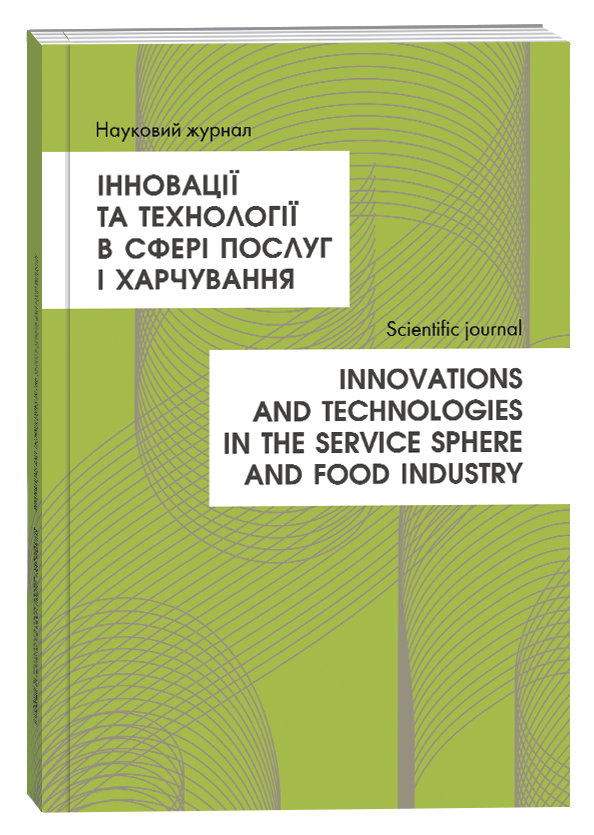ANALYSIS OF TECHNOLOGICAL SOLUTIONS FOR OPTIMIZATION OF FUNCTIONAL GLUTEN-FREE PRODUCT FORMULATIONS
Abstract
The exclusion of gluten from traditional recipes creates several technological challenges, in particular, the loss of structure-forming properties of the dough, which negatively affects the finished product's texture, appearance and taste characteristics. Many gluten-free alternatives are characterised by reduced nutritional value, necessitating careful selection of raw materials and technological approaches to preserve or increase the content of biologically active substances, minerals and vitamins. In this context, there is a need to create recipes that would combine gluten-free with high organoleptic and functional indicators. The study's relevance is due to the increasing prevalence of celiac disease, gluten intolerance and the growing demand for gluten-free products among wide segments of the population, including supporters of healthy eating. The creation of high-quality, functional, gluten-free products remains a relevant scientific and practical problem, requiring the search for effective technological solutions to increase nutritional value, improve organoleptic properties and ensure product stability during storage. The article presents the results of a study aimed at analyzing technological solutions for optimizing recipes for functional gluten-free bakery products. The object of study was experimental bread samples made from concentrates containing pea flour, buckwheat flour and buckwheat bran, and commercial samples of gluten-free and wheat-rye bread. The physicochemical, sensory and textural characteristics of bread were studied, including porosity, volume, moisture, taste properties and storage stability. The results indicate the feasibility of using legume and cereal components to improve the quality of gluten-free products and ensure their functional properties by enhancing the nutritional profile, including increased protein and dietary fiber content, as well as by contributing to improved texture, taste, and overall acceptability. The synergistic combination of these ingredients allows for better structural integrity in the absence of gluten, while also supporting the development of products that meet the dietary needs of individuals with gluten intolerance or celiac disease, without compromising on sensory and functional attributes. The data obtained can be used to improve gluten-free bread recipes considering the requirements for nutritional and consumer value.
References
Краєвська С., Піддубний В. Оцінка якості житньо-пшеничного хліба з пророщеним насінням льону. The International scientific-practical journal "Commodities and markets". 2023. Т. 48, № 4. С. 81–91. DOI: https://doi.org/10.31617/2.2023(48)07
Резвих Н. І. Аналіз органолептичних показників якості хліба пшеничного з підвищеною харчовою цінністю. Таврійський науковий вісник. Серія: Технічні науки. 2021. № 5. С. 24–31. DOI: https://doi.org/10.32851/tnv-tech.2021.5.4
Challenges in Development of Gluten-Free Breads / M. B. Mir et al. Gluten-free Bread Technology. Cham, 2021. P. 15–28. DOI: https://doi.org/10.1007/978-3-030-73898-3_2
Fruit and Vegetable Based Ingredients in Gluten Free Breads / F. Hameed et al. Gluten-free Bread Technology. Cham, 2021. P. 183–197. DOI: https://doi.org/10.1007/978-3-030-73898-3_11
Haque A., Morris E. R., Richardson R. K. Polysaccharide substitutes for gluten in non-wheat bread. Carbohydrate Polymers. 1994. Vol. 25, no. 4. P. 337–344. DOI: https://doi.org/10.1016/0144-8617(94)90060-4
Oručević Žuljević S., Spaho N. Bread Aroma and Flavour Creation Factors. The Science of Fermentation [Working Title]. 2024. DOI: https://doi.org/10.5772/intechopen.115114
Skendi A., Papageorgiou M., Varzakas T. High Protein Substitutes for Gluten in Gluten-Free Bread. Foods. 2021. Vol. 10, no. 9. P. 1997. DOI: https://doi.org/10.3390/foods10091997
Structural Aspects of Gluten Free Breads / M. Manzoor et al. Gluten-free Bread Technology. Cham, 2021. P. 71–87. DOI: https://doi.org/10.1007/978-3-030-73898-3_5
Sudheesh C., Aaliya B., Sunooj K. V. Role of Starch in Gluten-Free Breads. Gluten-free Bread Technology. Cham, 2021. P. 155–181. DOI: https://doi.org/10.1007/978-3-030-73898-3_10
Technological Aspects of Gluten Free Bread / K. Muzaffar et al. Gluten-free Bread Technology. Cham, 2021. P. 29–48. DOI: https://doi.org/10.1007/978-3-030-73898-3_3
Kraievska S., Piddubnyi V. (2023) Otsinka yakosti zhytnʹo-pshenychnoho khliba z proroshchenym nasinnyam lʹonu [Quality assessment of rye-wheat bread with germinated flax seeds]. The International scientific-practical journal "Commodities and markets", vol. 48(4), pp. 81–91. DOI: https://doi.org/10.31617/2.2023(48)07 (in Ukrainian)
Rezvykh N. I. (2021) Analiz orhanoleptychnykh pokaznykiv yakosti khliba pshenychnoho z pidvyshchenoiu kharchovoiu tsinnistiu [Analysis of organoleptic quality indicators of wheat bread with increased nutritional value]. Tavriiskyi naukovyi visnyk. Seriia: Tekhnichni nauky – Tavriiskyi Scientific Bulletin. Series: Technical Sciences, no. 5, pp. 24–31. DOI: https://doi.org/10.32851/tnv-tech.2021.5.4 (in Ukrainian)
Mir M. B., Nawaz M. A., Hameed F., Shokat H., Manzoor M. (2021) Challenges in development of gluten-free breads. In: Gluten-free Bread Technology (pp. 15–28). Cham: Springer. DOI: https://doi.org/10.1007/978-3-030-73898-3_2
Hameed F., Nawaz M. A., Mir M. B., Shokat H., Manzoor M. (2021) Fruit and vegetable based ingredients in gluten free breads. In: Gluten-free Bread Technology (pp. 183–197). Cham: Springer. DOI: https://doi.org/10.1007/978-3-030-73898-3_11
Haque A., Morris E. R., Richardson R. K. (1994) Polysaccharide substitutes for gluten in non-wheat bread. Carbohydrate Polymers, vol. 25(4), pp. 337–344. DOI: https://doi.org/10.1016/0144-8617(94)90060-4
Oručević Žuljević S., Spaho N. (2024) Bread aroma and flavour creation factors. In: The Science of Fermentation [Working Title]. DOI: https://doi.org/10.5772/intechopen.115114
Skendi A., Papageorgiou M., Varzakas T. (2021) High protein substitutes for gluten in gluten-free bread. Foods, vol. 10(9), 1997. DOI: https://doi.org/10.3390/foods10091997
Manzoor M., Nawaz M. A., Hameed F., Shokat H., Mir M. B. (2021) Structural aspects of gluten free breads. In: Gluten-free Bread Technology (pp. 71–87). Cham: Springer. DOI: https://doi.org/10.1007/978-3-030-73898-3_5
Sudheesh C., Aaliya B., Sunooj K. V. (2021) Role of starch in gluten-free breads. In: Gluten-free Bread Technology (pp. 155–181). Cham: Springer. DOI: https://doi.org/10.1007/978-3-030-73898-3_10
Muzaffar K., Nawaz M. A., Hameed F., Shokat H., Mir M. B. (2021) Technological aspects of gluten free bread. In: Gluten-free Bread Technology (pp. 29–48). Cham: Springer. DOI: https://doi.org/10.1007/978-3-030-73898-3_3



